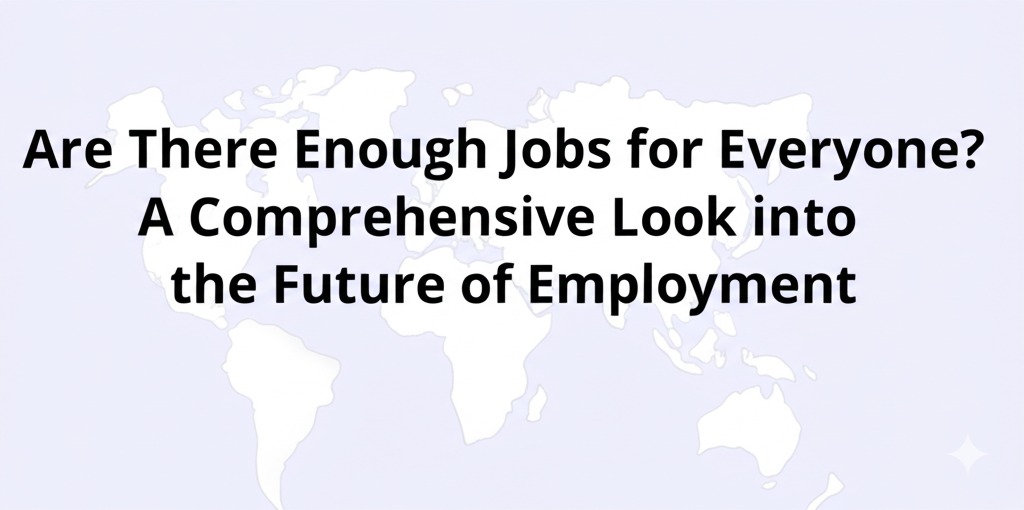
In today’s rapidly evolving world, the question of whether there are enough jobs for everyone is more relevant than ever. With automation, artificial intelligence, and global economic shifts transforming the job market, many people are left wondering if their career aspirations will align with future opportunities. In this article, we’ll explore the current job landscape, future trends, challenges, and solutions, shedding light on this critical question.
Understanding the Job Market: An Overview
The global job market is complex, constantly shifting, and often influenced by various factors such as technology, demographics, and economic cycles. At the heart of this complexity lies a fundamental question: Are there enough jobs to meet the needs of a growing and diverse global population?
In 2023, the global labor force was approximately 3.5 billion people, and by 2030, it is expected to expand even further. Despite this growth, the availability of jobs is not always in line with demand, and disparities in job opportunities can be seen across different regions and industries.
The Role of Technology in Job Creation and Destruction
The Rise of Automation and Artificial Intelligence
One of the most significant factors affecting the availability of jobs is technological advancement. Automation, machine learning, and artificial intelligence (AI) are revolutionizing industries, leading to both job creation and job displacement.
- Job Creation: New industries, such as tech, renewable energy, and data science, are thriving thanks to technological innovations. Jobs like AI specialists, data scientists, and renewable energy engineers didn’t exist a decade ago but are now in high demand.
- Job Displacement: On the flip side, many jobs in traditional industries—such as manufacturing and clerical roles—are at risk due to automation. Robots and algorithms are increasingly able to perform tasks that once required human intervention, leading to a reduction in the number of available positions in certain sectors.
Despite the rise of automation, experts suggest that rather than eliminating jobs entirely, technology will shift the nature of work, requiring workers to adapt and acquire new skills.
Global Demographics: Who Needs Jobs?
A Growing Global Workforce
The world’s population is steadily growing, with projections indicating that it will reach around 9.7 billion by 2050. This increase will naturally lead to a higher demand for jobs across various sectors. However, the challenge lies in how well different regions can accommodate this growth.
- Developed vs. Developing Economies: While job opportunities are often abundant in developed economies, many developing countries struggle with high unemployment rates and underemployment. According to the International Labour Organization (ILO), youth unemployment rates are particularly high in regions like Sub-Saharan Africa and parts of the Middle East.
- Aging Populations in Developed Countries: In countries like Japan and many European nations, the population is aging rapidly. While this creates demand for healthcare and caregiving jobs, it also presents a challenge—fewer younger workers are entering the job market to replace retiring baby boomers.
Education and Skill Development: Bridging the Gap
The Importance of Lifelong Learning
To ensure that there are enough jobs for everyone, it’s crucial that individuals are equipped with the skills that match the demands of the evolving job market. The rise of automation and AI has made it clear that continuous education and skill development will be key to long-term employment.
- STEM Education: In today’s digital age, education in science, technology, engineering, and mathematics (STEM) fields is becoming increasingly valuable. Many of the fastest-growing careers are in sectors like software development, biotechnology, and renewable energy.
- Soft Skills Matter: While technical expertise is important, soft skills such as creativity, emotional intelligence, and problem-solving are just as critical. These skills are less likely to be replaced by machines and will remain in high demand.
Workforce Reskilling and Upskilling
For those already employed, the future will demand a commitment to reskilling and upskilling. Workers in industries at risk of automation need to acquire new skills that will make them valuable in emerging sectors. Governments, corporations, and educational institutions all have a role to play in ensuring that workers have access to training programs that enable them to transition into new careers.
Economic Shifts and the Changing Nature of Work
The Gig Economy: A Double-Edged Sword
In recent years, the gig economy has experienced explosive growth. Companies like Uber, Airbnb, and freelance platforms have created flexible job opportunities that allow individuals to earn income outside of traditional employment structures. However, while gig work can provide income, it often lacks the stability, benefits, and long-term security of traditional full-time employment.
- Benefits: Gig work allows for flexibility, offering people the chance to work on their own terms. It also provides opportunities for those who may not be able to commit to a 9-to-5 job, such as students or caregivers.
- Drawbacks: Many gig workers face issues like inconsistent pay, lack of job security, and no access to healthcare or retirement benefits. This makes it difficult for many to rely solely on gig work for long-term financial stability.
As gig work becomes more widespread, discussions about workers’ rights, fair pay, and benefits for freelancers and contractors are becoming increasingly important.
Is There a Job for Everyone?
The Role of Government and Policy
Ultimately, the question of whether there are enough jobs for everyone depends on a combination of factors—technology, education, global economic trends, and government policy. Governments around the world play a vital role in shaping the job market through policies that encourage innovation, support job creation, and provide safety nets for workers.
- Job Creation Initiatives: Governments can promote job growth by investing in infrastructure, education, and technology. Policies that support entrepreneurship and small business development also encourage job creation in local communities.
- Social Safety Nets: A robust social safety net, including unemployment benefits, healthcare, and retraining programs, can help those displaced by automation and economic shifts. These measures ensure that people have the support they need to transition into new careers.
Conclusion: Moving Forward with Optimism
The question of whether there are enough jobs for everyone is multifaceted. While challenges exist, the potential for job creation is also vast. By embracing technological advances, investing in education and skills training, and implementing policies that encourage job growth, we can work toward a future where the majority of people have access to meaningful employment.
If you’re concerned about the future of work, consider investing in continuous learning, adaptability, and staying informed about shifts in the job market. The future of employment is not set in stone—but with the right preparation, there is a job for everyone.

Andre Cuevas provides career insights, job search strategies, and professional advice to help individuals navigate the job market and achieve their career goals.





